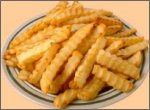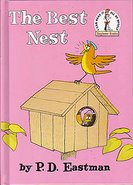Some people swear by the mantra "everything in moderation," but the truth is, some foods, no matter how good they taste, are better off left alone.
If you need a little motivation to stay away from these most unhealthy foods, consider that four of the 10 leading causes of death in the United States are related to diet (
diabetes, heart disease, cancer and stroke). And if you're looking to improve yours, cutting back on these six foods is a great place to start. Want to guess first? Read the hints below.
Hints:
#1 is basically liquid candy.
#2 contains
acrylamide, a known carcinogen and neurotoxin.
#3 contains nothing more than refined sugar and flour, artificial flavors and partially hydrogenated oil that's loaded with trans fats.
#4 pertains to a store bought version of something . . . it contains high amounts of trans fats and a host of other unsavory additives. Homemade version? A bit better.
#5 has almost 1,000 milligrams of salt in one small serving.
πππππππππππππππππππππππππππππππππππππππππππππππππππππππππππππππ
Ready for the 6 six things you should delete from your diet? Did you already guess?
1. Soda.
An average can of soda has 10 teaspoons of sugar, 150 calories, 30 to 55 mg of caffeine, artificial food colors and sulphites. Diet sodas have the even-more-unhealthy artificial sweeteners. A major part of the problem is that sodas have become a staple in many people's diets. A study in the journal Pediatrics found that 56 percent to 85 percent of children consume at least one soft drink a day, and 20 percent of adolescent males drink four or more sodas a day.
"Parents and health officials need to recognize soft drinks for what they are -- liquid candy -- and do everything they can to return those beverages to their former role as an occasional treat," says the Center for Science in the Public Interest
(CSPI), a U.S. consumer group. In fact, CSPI has recently petitioned the Food and Drug Administration
(FDA) calling for cigarette-style warnings on soft drinks to warn people of their potential health risks
(weight gain, diabetes, tooth decay and more).
| You knew it was coming ... French fries contain at least two types of cancer-causing compounds. |
2. Potato Chips and French Fries.
These popular snack foods contain acrylamide, a known carcinogen and neurotoxin that is formed when foods are baked or fried at high temperatures. "I estimate that acrylamide causes several thousand cancers per year in Americans," said Clark University research professor Dale Hattis.
When CSPI conducted tests on some popular brands of French fries and chips, they found that the acrylamide in a large order of fast food fries was at least 300 times the amount allowed by the Environmental Protection Agency
(EPA) in a glass of water.
"There has long been reason for Americans to eat less greasy French fries and snack chips," said CSPI executive director Michael F. Jacobson. "Acrylamide is yet another reason to eat less of those foods."
An Up-and-Coming Absolute Worst Food ... Don't Try This at Home This one wasn't popular enough to make the top-six list yet, but it's growing in popularity ... and growing fast. The deep-fried Twinkie, first invented in a Brooklyn restaurant by brothers Clint and Rocky Mullen, is making its rounds to country fairs and carnivals around the country.
Here's how they're made:
• Twinkies are chilled, rolled in flour, dipped in tempura batter and fried for a minute or two.
• The frying process melts the cream center, which becomes infused throughout the cake, giving it a pudding-like texture.
• For the finale, they're sprinkled with powdered sugar and served with chocolate or berry sauce.
If you're not into Twinkies, don't despair. The Mullen brothers also sell deep-fried candy bars--Snickers, 3 Musketeers and Milky Way--to suit even the most discerning tastes. |
But that's not all. These foods also contain trans fats, the artery-clogging fat that's been linked to raising bad cholesterol
(and lowering the good kind), and increasing the risk of heart disease, diabetes, stroke and cancer.
| Doughnuts: A somehow tasty concoction of refined sugar, flour, trans fats and artificial flavors with zero nutritional value. |
3. Doughnuts.
Tasty, yes. But break a doughnut down and you'll find nothing more than refined sugar and flour, artificial flavors and partially hydrogenated oil that's loaded with trans fats. They have no redeeming qualities whatsoever.
"When it comes to health, the only thing good about them is the hole," said Carla Wolper, nutritionist at the New York Obesity Research Center.
4. Skip the Pre-Packaged Baked Goods
This category actually includes all varieties of baked goods, including packaged cake and biscuit mixes. What makes these foods so bad is that they almost always contain high amounts of trans fats and a host of other unsavory additives including corn syrup, preservatives and artificial flavors and colors. In fact,
commercial baked goods typically contain more trans fats than any other food because not only are they often made with hydrogenated oils, they're fried in them too.
If you're not ready to give up your morning treat just yet, opt for baked goods from your local bakery
(which is less likely to use hydrogenated oil for a long shelf-life and is likely to use butter instead of margarine, which typically contains trans fat) or . . . .
MAKE THEM YOURSELF!
| A hot dog now and then can be reasonably healthy if you seek out a nitrite/nitrate-free variety. |
5. Luncheon Meats/Hot Dogs.
Processed meats like these
(and others including sausages, bacon, pepperoni and other processed meats) contain a carcinogenic precursor ingredient known as sodium nitrite
(sodium nitrate is closely related).
"Sodium nitrite is a dangerous, cancer-causing ingredient that has no place in the human food supply," says nutritionist Mike Adams, author of the Grocery Warning Manual.
And, according to a University of Hawaii study that followed nearly 200,000 people for seven years, people who consumed the most processed meats
(hot dogs and sausage) showed a 67 percent increased risk of pancreatic cancer over those who consumed little or no meat products.
Here's some good news: you can find various varieties of nitrite/nitrate-free meats in any health food store.
6. Canned Soup.
Here we're talking about the traditional, canned soups you find in your grocery store. This may come as a surprise, but most canned
(and packaged) soups have high levels of trans fats, sodium and artificial preservatives like MSG. Just one cup of canned soup can have almost 1,000 milligrams of salt
(and most people eat more than one cup), which is tons considering dietary guidelines recommend consuming no more than 2,400 milligrams for the entire day.
There are healthy options out there, particularly natural, organic brands, but be sure to read the label. The alternative is, of course, to make your own homemade variety.
__________________________________________________________________________________
Recommended Reading
The Top 8 Foods People Are Most Sensitive To -- Without Even Knowing It!
High Cholesterol? The TOP 12 Non-Drug Strategies to Increase Your HDL Levels
Sources
Original Article
Reuters July 13, 2005
What's Wrong With Trans Fats?
CSPI Newsroom
Doughnuts Get a Big Zero
Organic Consumers Association
CNN: New Junk Food Fad: Deep-Fried Twinkies
Cross posted @ Old Men's Gym and at Healthy Mom; Healthy Baby




























 It is well known that if pots or pans coated with Teflon are left on a stove without any food in them, pet birds living in the kitchen can easily die from the fumes given off. It’s a condition some vets call “Teflon
It is well known that if pots or pans coated with Teflon are left on a stove without any food in them, pet birds living in the kitchen can easily die from the fumes given off. It’s a condition some vets call “Teflon 


 ”, “Titanium Cracker”, “Dragon’s Wrath”, “Big Mama Jama”, “Brutal Force”,“Nuke Power”, “Pull String Grenade”, “Assorted Color Ammo Smoke”, “Caliber Blast”, “Car Bomb”, “Big Earthquake”, “Jumboshell Fountain”, “Pyrogyro”, “Cracker Jack in a Box”, “Deadly Fire”, “Battle of New Orleans”, “Pay Back”, “Mucho Grande – small” (isn’t that an oxymoron?), “Air Raid”, or of course the ever popular “So X*@! Good”?
”, “Titanium Cracker”, “Dragon’s Wrath”, “Big Mama Jama”, “Brutal Force”,“Nuke Power”, “Pull String Grenade”, “Assorted Color Ammo Smoke”, “Caliber Blast”, “Car Bomb”, “Big Earthquake”, “Jumboshell Fountain”, “Pyrogyro”, “Cracker Jack in a Box”, “Deadly Fire”, “Battle of New Orleans”, “Pay Back”, “Mucho Grande – small” (isn’t that an oxymoron?), “Air Raid”, or of course the ever popular “So X*@! Good”?





